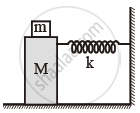Advertisements
Advertisements
Question
In the given figure, a mass M is attached to a horizontal spring which is fixed on one side to a rigid support. The spring constant of the spring is k. The mass oscillates on a frictionless surface with time period T and amplitude A. When the mass is in equilibrium position, as shown in the figure, another mass m is gently fixed upon it. The new amplitude of oscillation will be:

Options
`"A"sqrt("M"/("M"+"m"))`
`"A"sqrt("M"/("M"-"m"))`
`"A"sqrt(("M"-"m")/"M")`
`"A"sqrt(("M"+"m")/"M")`
Solution
`bb("A"sqrt("M"/("M"+"m")))`
Explanation:
As there are no impulsive forces, momentum will always be conserved.
`"MA"((2pi)/"T"_1) = ("m"+"M") "A"_1 ((2pi)/"T"_2)` ...(i)


T1 = 2π `sqrt("M"/"K")`
T2 = 2π `sqrt(("M"+"m")/"K")`
Now, substituting the value of T1 and T2 in equation (i).
`"MA"((2pi)/(2pisqrt("M"/"K"))) = ("m"+"M" ) "A"_1 ((2pi)/(2pisqrt(("M"+ "m")/"K")))`
⇒ A1 = `("MA"sqrt"K"/"M")/(("m"+"M")sqrt("K"/("M"+ "m")))`
⇒ A1 = A `sqrt"M"/("M"+"m")`
